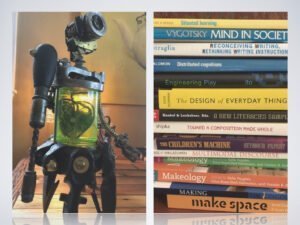
Session 2: Building Community & Trust

Plans for Session 2: Community & Trust (Sept 30)
Writing into the day: As we join the Zoom session, we’ll write briefly in our Currents Community in response to this idea: What does participation look like in your class? How do students share ideas? Do they get to talk to each other through writing or in discussions? How are the structures of your class enabling participation; what might be getting in the way?
We’ll share ideas from our writing and think about what makes participation challenging, perhaps particularly in online courses.
Kim will share a few examples from her courses for building community, with a focus on noticing student ideas as a way to build trust and community. (Note: See the video under additional resources, “Designing for Connection and Community…” for a conversation about the ideas and examples from the bulleted list below)
- pre-class surveys: example
- tone of the syllabus: example
- introductions and quick feedback. Students connecting to each other.
- agency over groups: creating group norms
- notice interesting thinking: “golden lines,” thoughtful questions, comments from readings. example
- share in emails, in videos, on the website
- Choice built into readings or assignments. example
- Connecting when students or their assignments are missing.
- Review Board: From “Epic Learning: Large Class as Intentional Design”
- The Review Board is responsible for reading the work of their peers and nominating writers to be featured in class. The review board’s job is to present the writing, talk about why they think the writing represents some of the best thinking that week, pose questions to the featured writer about her choices, and celebrate their peers. I am always impressed by this small Review Board team: without prompting they will often ask “what was the purpose of the writing this week?” Or they will say, “we featured her work last week; we should make sure someone else is featured.” The students recognize that the writing is intentional and that we value the ideas from as many students as possible in our class. Each week, a new batch of scholars emerge and are highlighted in our space — and over time — we build a community where the students are noticed.
Read and comment on “A Guide to Resisting EdTech…” together in Perusall. We’ll think about trust and building community in online spaces.
Question: What is one thing (syllabus language, activity, assignment, processes for communicating) you could revise to support participation, trust, and/or community building?
Questions and prep for next time…Wednesday, Oct 14: How do students demonstrate what they know beyond the discussion post and the quiz?
Additional Resources:
Jean Lave & Etienne Wenger’s Situated Learning: Legitimate Peripheral Participation
Etienne Wenger’s Communities of Practice: Learning Meaning and Identity
Conversation and resources for building community in digital spaces. Webinar below. Link to additional resources from the webinar here.
Kim Jaxon’s “Course Design for the Now Times” and “Rescuing Student Participation Through Digital Platforms.”
Mike offers a series focused on “teaching without walls.” Ideas for engaging students offline and simple video ideas.
Shea Swauger’s “Our Bodies Encoded: Algorithmic Proctoring in Higher Education.”
Audrey Watters’ “The Weaponization of Education Data.”
